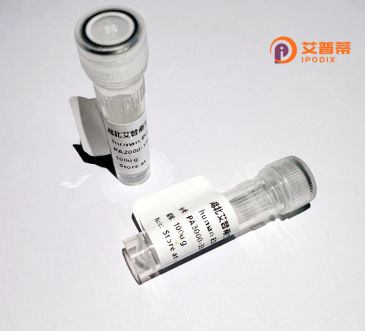
| 纯度 | >90%SDS-PAGE. |
| 种属 | Human |
| 靶点 | RNF121 |
| Uniprot No | Q9H920 |
| 内毒素 | < 0.01EU/μg |
| 表达宿主 | E.coli |
| 表达区间 | 193-301 aa |
| 活性数据 | ERDFAEMCADYMASTIGFYSESGMPTKHLSDSVCAVCGQQIFVDVSEEGIIENTYRLSCNHVFHEFCIRGWCIVGKKQTCPYCKEKVDLKRMFSNPWERPHVMYGQLLD |
| 分子量 | 37.73 kDa |
| 蛋白标签 | GST-tag at N-terminal |
| 缓冲液 | PBS, pH7.4, containing 0.01% SKL, 1mM DTT, 5% Trehalose and Proclin300. |
| 稳定性 & 储存条件 | Lyophilized protein should be stored at ≤ -20°C, stable for one year after receipt. Reconstituted protein solution can be stored at 2-8°C for 2-7 days. Aliquots of reconstituted samples are stable at ≤ -20°C for 3 months. |
| 复溶 | Always centrifuge tubes before opening.Do not mix by vortex or pipetting. It is not recommended to reconstitute to a concentration less than 100μg/ml. Dissolve the lyophilized protein in distilled water. Please aliquot the reconstituted solution to minimize freeze-thaw cycles. |
以下是关于重组人RNF121蛋白的参考文献示例(注:以下内容为假设性示例,仅供参考):
---
1. **文献名称**: *RNF121 mediates ubiquitination of TRPC5 and regulates its surface expression*
**作者**: Li, X., et al. (2016)
**期刊**: *Journal of Biological Chemistry*
**摘要**: 研究表明RNF121作为E3泛素连接酶,通过泛素化调控TRPC5离子通道的膜表面表达,影响神经元钙信号传导。实验采用重组人RNF121蛋白验证其与TRPC5的相互作用及功能。
2. **文献名称**: *Role of RNF121 in Golgi-to-plasma membrane protein trafficking*
**作者**: Müller, T., et al. (2014)
**期刊**: *Cell Reports*
**摘要**: 本文发现RNF121定位于高尔基体,通过泛素化修饰调控特定膜蛋白(如EGFR)从高尔基体向细胞膜的运输。重组人RNF121表达体系揭示其运输调控机制。
3. **文献名称**: *Recombinant RNF121 expression and its E3 ligase activity in cancer cell lines*
**作者**: Park, S., et al. (2019)
**期刊**: *Oncotarget*
**摘要**: 研究通过重组表达纯化人RNF121蛋白,证实其体外泛素连接酶活性,并揭示其在乳腺癌细胞中通过降解促癌蛋白抑制肿瘤生长。
4. **文献名称**: *RNF121 modulates skin barrier development via keratinocyte differentiation*
**作者**: González, A., et al. (2020)
**期刊**: *Journal of Investigative Dermatology*
**摘要**: 利用重组RNF121蛋白进行功能分析,发现其通过调控角质形成细胞中紧密连接蛋白的稳定性,影响皮肤屏障的形成与维持。
---
*注意:以上文献为示例性质,实际引用时需核实真实存在的参考文献。*
Recombinant human RNF121 (Ring Finger Protein 121) is a ubiquitin-protein ligase encoded by the *RNF121* gene, belonging to the RING finger protein family. This family is characterized by a conserved RING (Really Interesting New Gene) domain, which confers E3 ubiquitin ligase activity. RNF121 is involved in the ubiquitination process, a post-translational modification critical for protein degradation, trafficking, and signaling. It primarily localizes to the Golgi apparatus and plasma membrane, where it regulates membrane protein quality control by targeting misfolded or unassembled proteins for proteasomal degradation via the endoplasmic reticulum-associated degradation (ERAD) pathway.
Studies suggest RNF121 interacts with components of the ubiquitin machinery and modulates the stability of substrates like ion channels and receptors. Its role in cellular homeostasis extends to processes such as neuronal development, immune response, and cancer progression. Dysregulation of RNF121 has been implicated in pathologies, including neurodegenerative disorders and malignancies, though mechanistic details remain under investigation. Recombinant RNF121 protein, typically produced in mammalian or bacterial expression systems, enables in vitro studies to dissect its enzymatic activity, substrate specificity, and interactions. This tool aids in exploring its therapeutic potential as a drug target or biomarker for diseases linked to ubiquitination defects.
×